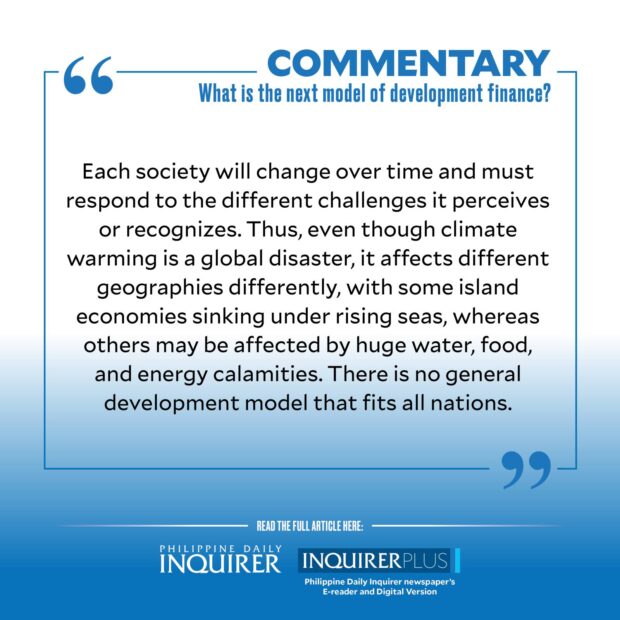What is the next model of development finance?

Money makes the world go round, so sang Sally Bowles in the famous movie “Cabaret.” Money today keeps the global economy ticking, and if the central banks stop printing money, we would already be in a 1930s Depression. So why is the story of money so powerful and yet mainstream development theory and models ignore the role of finance?
Until the 2008 financial crisis, mainstream economic models used by central banks and governments and International Monetary Fund/World Bank, etc. were built on the dynamically stochastic general equilibrium model which looked at real economy of production and consumption in value-added (GDP) terms. Finance was ignored because the financial sector is an intermediary between the real sectors of households, government, corporations, and foreigners, and its assets and liabilities net out to zero.
This academic and policy GDP-based blindness to money had three critical blindspots: the underpricing of pollution or planetary costs, the assumption that the political structure would remain the same; and that shocks to the economic system were exogenous (externally generated) rather than endogenous (internal financial fragility from contagion). Thus, all three blindspots created a delusion that finance was benign, the global economy was stable, and there were no planetary nor political costs from the “no limits” growth model of today. We are staring at the abyss of crossing three limits: 1) debt, in which United States Federal debt has exceeded $34 trillion or just over 30 percent of world GDP; 2) social inequality, in which the rich are getting richer so that there are increasing protests by the poor across the world; 3) planetary limits in terms of natural resources, where we need 1.7 Earths to meet current consumption needs. If everyone on the planet consumes like the average American, five Earths are necessary.
Modern development theory stemmed from World War II, which evolved four models: the US-led-Washington Consensus free-trade, neoliberal model; the East-Asian export-oriented industrialization model: the Soviet Union centrally planned model, and the Indian/Latin American import-substitution, domestic industrialization model. History has proved that the export-based industrialization model worked best within the Washington Consensus of free trade and promoted globalization of trade and investments, but the other two largely failed due to too-much inward orientation. If you don’t learn through open competition, you cannot reach economies of scale through too small domestic markets.
Now that globalization has somewhat peaked, with the rich countries becoming more protectionist and concentrating on decoupling or de-risking global supply chains to make them more “resilient,” what is the next development model? The game has changed because technology diffusion, talent migration, and climate change/natural disasters have meant that different countries can adopt very different models from the past.
We can decipher that it is not simply West versus the Rest, because the Rest includes two very different but overlapping parts—China and Russia as one camp of nuclear powers with huge manufacturing and military capacity, and the Middle East (other than Israel), Africa, Latin America, South and Southeast Asia forming the Global South. The BRICS grouping does not just include the large population giants of Brazil, Russia, India, China, and South Africa, but also new members such as Saudi Arabia, United Arab Emirates, Iran, Egypt, and Ethiopia.
The Global South can choose to side with either the West or the East depending on which side gives them more goodies (or less threats and costs). The development model cannot be independent of geopolitical strategy. Asean is looking to be nonaligned but will focus on development and trade, rather than following any geopolitical ideology.
In other words, each society will change over time and must respond to the different challenges it perceives or recognizes. Thus, even though climate warming is a global disaster, it affects different geographies differently, with some island economies sinking under rising seas, whereas others may be affected by huge water, food, and energy calamities. There is no general development model that fits all nations.
In a world of higher risk and volatility, countries must all deleverage, meaning focus on equity rather than debt. Risk-averse banking will continue to fund payments and liquidity needs, but the high-risk tech and supply chain restructuring will need more risk equity. This is where Hong Kong, as one of the most vibrant equity markets in the region or indeed any regional stock market, must step up to rethink how it can play a different role in development finance in the coming days.
Without a fundamental response to changing times, all economies face marginalization or decline. The risk is the opportunity, but only for those who are brave enough to grab them. Asia News Network
Andrew Sheng is former chair of the Hong Kong Securities and Futures Commission.
The Philippine Daily Inquirer is a member of the Asia News Network, an alliance of 22 media titles in the region.
















